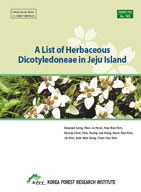21
2023.07.
Briefing<R&D Technology Roadmap '23~'27>
Forecasting forest fires and landslides with artificial intelligence (AI) and establishing digital forest management with CAS500-4 satellites.- National Institute of Forest Science announces R&D Technology Roadmap (TRM) over the next five years ('23~'27)The National Institute of Forest Science (NIFoS, President Bae, Jae Soo) announced a mid-term implementation plan (Technology Roadmap, TRM) for forest science research over the next five years at the Daejeon Government Complex on July 5 in response to public demand for forests and scientifically solve national issues such as climate crisis, major disasters, digital transformation, and global level orientation. In order to achieve the plan, 19 strategic tasks were systematically organized under six major themes, and the key research topics are as follows. First, it plans to strengthen research in response to forest disasters. It is planning to install an intelligent fire extinguishing helicopter operation algorithm that can respond to large forest fires at the same time as faster and more accurate forest fire risk prediction system than before. In addition, it is intended to integrate the slope management system between ministries and provide sophisticated risk prediction information to resolve the blind spot of landslide disasters. Moreover, it will present guidelines for the comprehensive management of four major forest pests, including pine wilt disease, and select pine trees that are resistant to pine wilt disease. Second, it plans to strengthen the construction of digital forest information. The National Forest Satellite Information Utilization Center (tentatively named) will be established to receive forest observation data from CAS500-4 satellites to be launched in 2025, closely monitor forests on the Korean Peninsula, and establish a quasi-real-time forest information sharing platform to provide it to the public. In addition, we intend to lead international forest cooperation by sharing observation images with countries around the world. Third, it plans to increase the added value of wood and expand its carbon-neutral contribution. In order to build public buildings and apartment facilities into wooden buildings, we intend to develop technologies that will enhance the value of wooden architecture, such as fire resistance and noise blocking, to use life space in the city as carbon storage and contribute to national greenhouse gas reduction. Fourth, it plans to develop a forest circulation management model and strengthen research to increase the income of forestry workers. It aims to contribute to making forests a happy workplace and source of income by developing a management model that can increase profitability while considering the forest ecosystem and developing new varieties and cultivation technologies of forest products. Fifth, it plans to develop an international forest cooperation model that contributes to the national interest and fits the national prestige. It aims to contribute to expanding international forest cooperation and strengthening cooperative relations by developing measures to transfer international reduction performance in the forest sector to achieve Nationally Determined Contribution (NDC) of ROK.In addition, △ solving social disasters such as fine dust and heat waves in urban forests △ replacing petrochemical-based materials with eco-friendly wood, strengthening the role of forests △ preserving and restoring science-based forest biodiversity △ discovering and distributing honey plants that both bees and forestry workers like. The NIFoS plans to reorganize its organization by establishing a National Forest Satellite Information Utilization Center (tentatively named) and separating and strengthening forest fire research and landslide research to fulfill its new mid-term research goals. In addition, the research project management regulations will be completely revised this year to expand budgets and facilities for smooth research progress and to carry out research projects more goal-oriented and performance-oriented. Bae, Jae Soo, President of the NIFoS, said, "As the only national forest research institute in Korea, we envision improving the world with forests, science and technology".
 Lost Landscape in Forest Wildfire-20year change at Eastern Coast of Korea
Lost Landscape in Forest Wildfire-20year change at Eastern Coast of Korea A list of Herbaceous Dicotyledoneae in Jeju Island
A list of Herbaceous Dicotyledoneae in Jeju Island
















 이 누리집은 산림청 누리집입니다.
이 누리집은 산림청 누리집입니다.